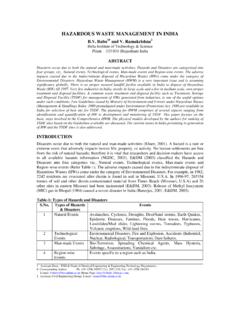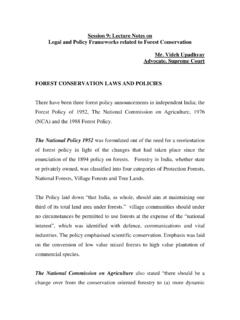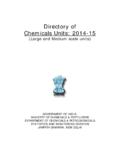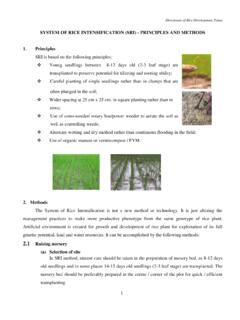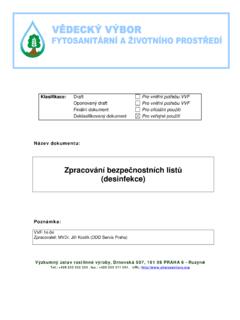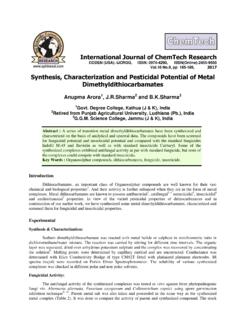Transcription of Better Management Practices in Sugarcane Farming …
1 Better Management Practices in Sugarcane Farming Systems 2 Better Management Practices in Sugarcane Farming Systems Content Chapter Page No. I. Introduction 1 II Improved Planting Technique 2 III Soil Management 7 IV Nutrient Management 8 V Irrigation Water Management 10 VI Interculture & Weed Control 29 VII Maturity & Harvesting 30 VIII Integrated Pest & Disease Management 31 IX Management of Ratoon Crop 35 X References 37 3I.
2 INTRODUCTION Maharashtra is one of the leading states in sugar and Sugarcane production in India. Sugarcane industry in Maharashtra is second largest agro-based industry next to cotton in which higher investment is made and has brought about desirable changes in social, economical, educational and political life in rural areas. In Maharashtra the highest harvested cane yields by farmers for Adsali/pre-seasonal; Suru and Ratoon have been 269, 217 and 202 T/ha respectively. However, the average yield of the State is about 85T/ha.
3 Thus there is wide gap between the average yields and potential yield. These production potential can be achieved by adopting Better irrigation water Management and scientific crop production Practices . The consumptive water needs of seasonal (one year) Sugarcane are between 1600 2000 mm in Maharashtra State depending upon agro climatic conditions. After effective rainfall, the annual net irrigation requirement is only 1200 to 1600 mm. Considering 20% field application losses, 1400 to 2000 mm is enough under surface irrigation condition.
4 Farmer s water use is 3000 to 4000 mm. It shows enormous wastage of water resource. The excess application result in water logging and salinity in the farm. These are man made problems. Adoption of any one of the modern irrigation techniques such as straight ridges and furrows with gentle slope, contour furrows, leveled furrows, drip irrigation and a combination of sprinkler plus straight furrows can reduce these problems. Adoption of modern irrigation techniques and best Management Practices will save about 50% water use on farm and will almost double the Sugarcane yield.
5 4II. Improved planting techniques 1. Planting Time In Maharashtra, Sugarcane is planted at three different times as given below. Planting /Ratoon Harvesting Seasonal (December to 15 February) February to April Pre-seasonal ( 15 October to 15 November) October to January Adsali (July August) October to January Ratoon (Ratoon of cane harvested during October to February) November to April (depending upon maturity) 2. Varieties Any of the following varieties may be selected. Variety Characteristics CO 86032 Resistant to smut and grassy shoot diseases, good ratooner, can sustain water stress, non-flowering.
6 CoC 671 Early maturity, moderately susceptible to smut, grassy shoot and stem borer (Recommended by Vasantdada Sugar Institute). CO 94012 Resistant to smut and stem borer, good ratooner, low flowering, high sugar recovery. 3. Method of planting Dry method of planting should be followed. Sets should be placed 5 to cm deep into soil. Care should be taken to place eye buds on side and covered with thin layer of soil and then irrigation should be given to the field. 54. Seed rate Single, two and three eye bud methods of planting are in practice.
7 To avoid heavy risk of gaps in single eye bud and over population by three eye bud planting methods, two eye bud method is recommended. About 25,000 two eye budded sets will be required to plant one hectare area. Only upper half or two third cane should be selected for planting as shown below. 6 While preparing set, care should be taken to maintain minimum distanc (one third inter node) above the eye bud and maximum distance below the eye bud (two third inter node) so as to obtain high germination. 5. Spacing Depending upon the soil type and method of irrigation, appropriate spacing should be adopted as given below.
8 Soil type Method of irrigation Furrow spacing Method of placement of set Spacing between two sets Coarse to medium textured soils Surface 90 cm Parallel to furrow cm Fine textured soils Surface 150 cm Across the furrow cm All kinds of soils Drip Paired row 75 cm X 150cm Parallel to furrow cm 7 Normal furrow Wider furrow Paired row In 75 or 90 cm furrows sets should be placed cm apart as shown below. In wider furrows (150 cm), sets should be placed across the length of furrow as shown below.
9 86. Seed treatment Seed treatment with hot water at 51 oC for two hours or moist air treatment at 54 oC for 21/2 hours. Sets should be dipped in solution of Bavistin (10 g Bavistin in 10 litres of water) or Bayleton ( ) (5 g Bayleton in 10 litres of water) for 10 to 15 minutes. If sets are infested with scale insect or wooly aphids, sets should be dipped in solution of Malathion ( 50EC), 30 ml or Dimethoate ( 30EC), 27 ml in 10 litres of water for 10 to 15 minutes. If fresh sets are not available for planting, sets should be dipped in solution of 500 g lime in 200 litres water for 12 to 24 hours.
10 To increase biological nitrogen fixation and solubility of phosphatic fertilizers, setts should be treated with Azatobacter and Phosphate solubilising inoculants. For one hectare area, dissolve 10 kg Azatobacter and 10 kg P-solubilising inoculant in 100 litres of water and dip sets for 10 15 minutes and then do planting after drying them in shade. 9 III. Soil Management 1. Suitability of soil Medium to fine textured, deep (depth > 1 m), rich in organic matter status, well drained, having pH between to are ideal for Sugarcane crop.


